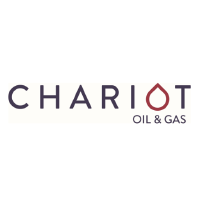
We could not find any results for:
Make sure your spelling is correct or try broadening your search.

Chariot Limited 04 December 2024 4 December 2024 Chariot Limited ("Chariot", the "Company") US$100 million in Guarantee Finance Secured from British International Investment and...
Chariot Limited 02 December 2024 2 December 2024 Chariot Limited ("Chariot" or the "Company") Block Admission Return The Company makes the following notification pursuant to Schedule Six...
Chariot Limited 05 November 2024 5 November 2024 Chariot Limited ("Chariot", the "Company") Directors Dealings The information set out below is provided in accordance with the...
Chariot Limited 22 October 2024 22 October 2024 Chariot Limited ("Chariot" or the "Company") Block Admission The Company announces that application has been made for the Block Admission of...
The following is a round-up of London-listed company director and manager changes announced this week and not separat ...
Chariot Limited 16 October 2024 16 October 2024 Chariot Limited ("Chariot", the "Company") Appointment of Chairman Chariot Limited (AIM: CHAR), the Africa focused transitional energy...
The following is a round-up of earnings for London-listed companies, issued on Friday and not separately reported by ...
Chariot Limited 27 September 2024 27 September 2024 Chariot Limited ("Chariot", the "Company") H1 2024 Results Chariot (AIM: CHAR), the Africa focused transitional energy company...
Chariot Limited 16 September 2024 16 September 2024 Chariot Limited ("Chariot", the "Company") Conclusion of Anchois-3 Drilling Campaign Offshore Morocco Chariot Limited (AIM:...
Chariot Limited 11 September 2024 11 September 2024 Chariot Limited ("Chariot", the "Company") Operational Update on Anchois-3 Drilling Offshore Morocco Chariot Limited (AIM: CHAR...
| Period | Change | Change % | Open | High | Low | Avg. Daily Vol | VWAP | |
|---|---|---|---|---|---|---|---|---|
| 1 | 0.142 | 8.12356979405 | 1.748 | 2.05 | 1.748 | 3690495 | 1.93840223 | DE |
| 4 | 0.108 | 6.06060606061 | 1.782 | 2.5 | 1.68 | 5393406 | 1.88638096 | DE |
| 12 | 0.3 | 18.8679245283 | 1.59 | 3.455 | 1.25 | 9896164 | 2.39563731 | DE |
| 26 | -5.21 | -73.3802816901 | 7.1 | 7.9 | 1.25 | 10924155 | 2.66583578 | DE |
| 52 | -8.43 | -81.6860465116 | 10.32 | 10.58 | 1.25 | 7963836 | 4.3923798 | DE |
| 156 | -5.75 | -75.2617801047 | 7.64 | 26.6 | 1.25 | 5352492 | 9.93355198 | DE |
| 260 | -1.3 | -40.7523510972 | 3.19 | 26.6 | 1.25 | 4083162 | 9.10955508 | DE |
 Napolion
18 years ago
Napolion
18 years ago
 smallcapfan
18 years ago
smallcapfan
18 years ago
 Napolion
19 years ago
Napolion
19 years ago
 Napolion
19 years ago
Napolion
19 years ago
 Napolion
19 years ago
Napolion
19 years ago
 Napolion
19 years ago
Napolion
19 years ago
 AxelUST
19 years ago
AxelUST
19 years ago
 SpillWay
19 years ago
SpillWay
19 years ago
 littlejohn
19 years ago
littlejohn
19 years ago
 Bobwins
19 years ago
Bobwins
19 years ago
 littlejohn
19 years ago
littlejohn
19 years ago
 Bobwins
19 years ago
Bobwins
19 years ago
 Napolion
19 years ago
Napolion
19 years ago
 Bobwins
19 years ago
Bobwins
19 years ago
 Napolion
20 years ago
Napolion
20 years ago
 FIFO_kid2
20 years ago
FIFO_kid2
20 years ago
 oil export
20 years ago
oil export
20 years ago

It looks like you are not logged in. Click the button below to log in and keep track of your recent history.
Support: 1-888-992-3836 | support@advfn.com
By accessing the services available at ADVFN you are agreeing to be bound by ADVFN's Terms & Conditions